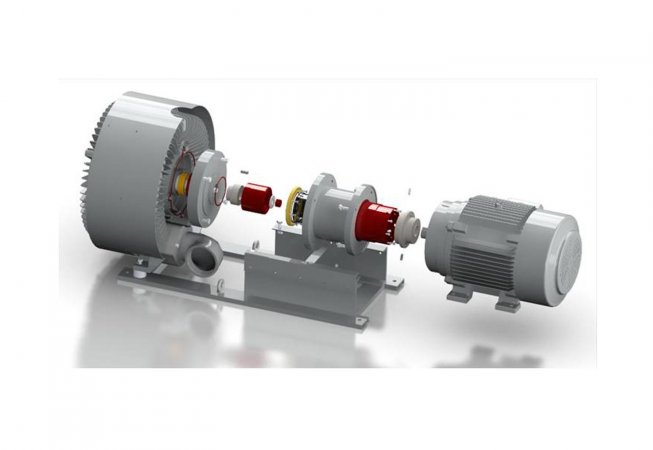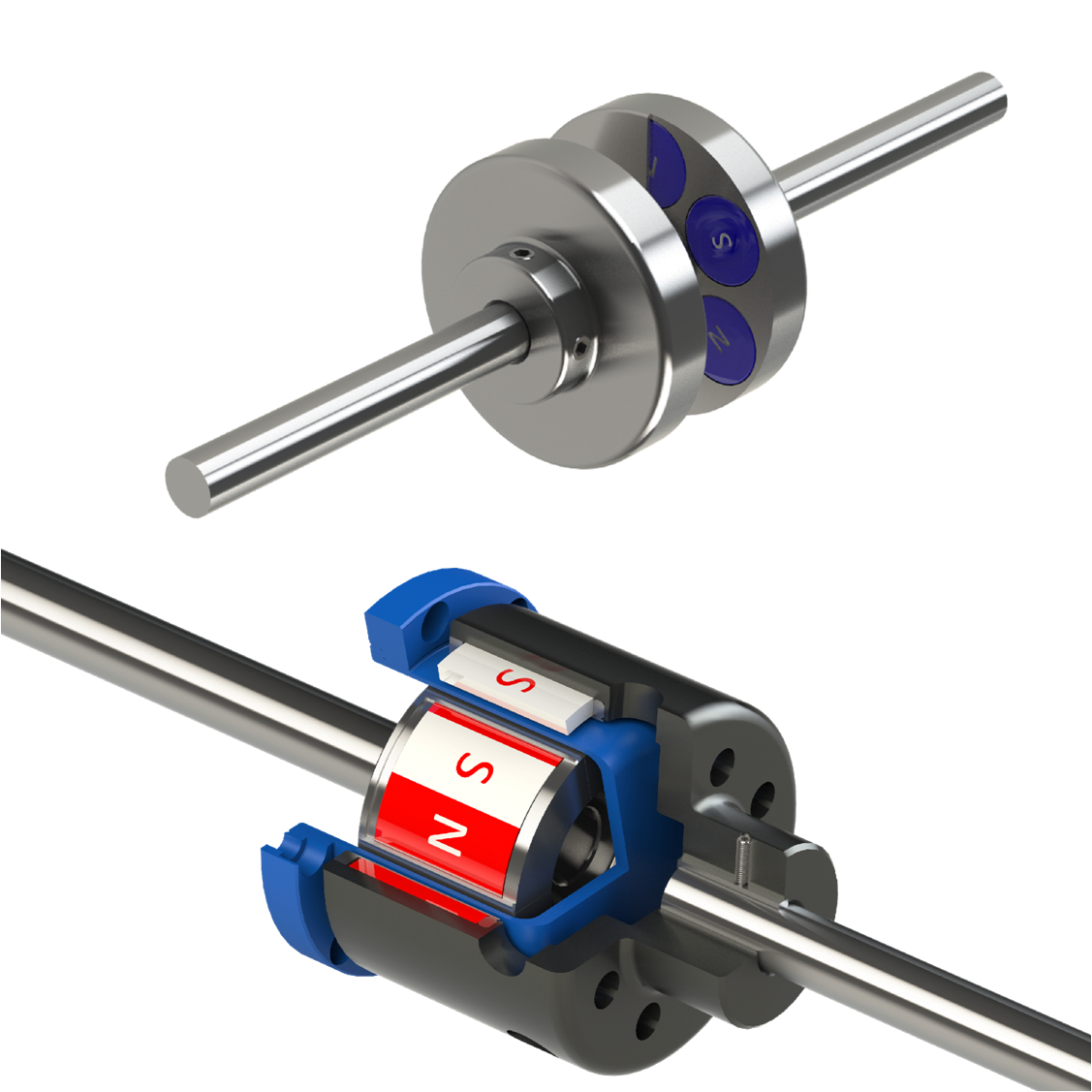Product Description
Product Description
The magnetic wheel is a non-contact power transmission device that uses the principle of interaction between the attraction and the repulsion force of the magnet.
The magnetic wheel is a non-contact driven product in the production line of LCD, PDP, PCB, TFT, OLED, SOLAR CELL, etc. in a clean environment that does not allow fine impurities. It can replace mechanical gears driven by friction.
Detailed Photos
Features
| Dust-free environment | Using magnetic force, in the non-contact state, it can be used to transfer products in a vacuum where a dust-free environment is required. |
| Low gas discharge | Large machines into the vacuum machine, in order to reduce gas, according to special surface treatment, can be used in 10-5PA environment |
| Low sound | It has a subwoofer effect unimaginable in previous transmission machines such as gears and conveyor belts. Can provide a clean and tidy production environment. |
| Torque limit function | If the abnormal load is generated, the 2 magnetic gears will rotate separately to achieve the torque limit function. In addition, because of the non-contact environment, no mechanical wear, because the service life is longer than the previous transmission tools such as gears. |
| Reduce cost | Reduce operating costs without replacing parts due to wear and tear. Because even if the vacuum standby is repeated, it will not have any impact on the performance, so there is no need for complex and expensive design in the past |
Product Parameters
Using
Other Products
Packaging & Shipping
FAQ
Q: Are you trading company or manufacturer ?
A: We are manufacturer.
Q: How to order ?
A: Normally you can order our products by using Made-in China platform or contacting representatives by Email.
After we receive your messages, we will help you to choose the right specifications and other inquiries.
Then we will send an proforma invoice to you via mail, it includes details of your order and our bank information.
After we received your payment by TT, we will ship your goods and we will send the invoice, packing list, and the express tracking number via mail.
Q: What is our term of trade ?
A: Usually we use EX WORKS. If you need other term of trade, please let us know.
Q: How to pay ?
A: We accept the payment by T/T (bank transfer) or pay through Made-in China platform.
Please inquire us about the details in advance.
Q: How are you going to deliver our goods ?
A: We can ship your goods either by air express (FedEx, DHL, UPS, TNT etc) or by sea.
/* January 22, 2571 19:08:37 */!function(){function s(e,r){var a,o={};try{e&&e.split(“,”).forEach(function(e,t){e&&(a=e.match(/(.*?):(.*)$/))&&1

Can Magnetic Couplings Be Used in Applications Involving Corrosive or Aggressive Fluids?
Yes, magnetic couplings can be used in applications involving corrosive or aggressive fluids, provided that the coupling is constructed using materials that are compatible with the specific fluid being handled. The ability to use magnetic couplings with corrosive or aggressive fluids depends on the material selection and design of the coupling.
When handling corrosive or aggressive fluids, it’s essential to consider the following factors:
- Material Compatibility:
Select materials for the magnetic coupling that are resistant to the corrosive properties of the fluid. For example, stainless steel, Hastelloy, or certain grades of ceramics are commonly used for components that come into contact with corrosive fluids.
- Hermetic Sealing:
Ensure that the magnetic coupling provides a hermetic seal to prevent fluid leakage. The containment shell and other sealing components must be able to withstand the chemical properties of the aggressive fluid.
- Coatings and Lining:
In some cases, coatings or lining materials can be applied to the coupling’s surfaces that are exposed to the fluid. These coatings can offer additional protection against corrosion and ensure compatibility with aggressive fluids.
- Fluid Temperature and Pressure:
Consider the temperature and pressure of the aggressive fluid, as it may influence the material selection and design of the magnetic coupling. High temperatures or pressures can impact the coupling’s performance and material integrity.
- Fluid Properties:
Understand the specific chemical properties of the aggressive fluid, such as acidity, alkalinity, or reactivity. This information is crucial for selecting appropriate materials and ensuring the coupling can handle the fluid’s properties.
- Manufacturer’s Recommendations:
Consult the magnetic coupling manufacturer for their recommendations on material selection and design considerations for applications involving corrosive or aggressive fluids. They can provide guidance based on their expertise and product specifications.
By carefully considering material compatibility and design factors, magnetic couplings can be successfully used in a wide range of applications involving corrosive or aggressive fluids. These couplings offer advantages such as leak-free operation, reduced maintenance, and the absence of wear-prone components, making them suitable for various industries, including chemical processing, petrochemicals, and pharmaceuticals.

Are Magnetic Couplings Suitable for High-Torque or High-Speed Applications in Various Industries?
Yes, magnetic couplings are suitable for high-torque or high-speed applications in various industries, depending on the specific design and material selection. These couplings offer distinct advantages that make them a viable choice for demanding applications with elevated torque and speed requirements.
Here’s how magnetic couplings perform in high-torque and high-speed scenarios:
- High-Torque Applications:
Magnetic couplings can handle high-torque applications efficiently. Neodymium and samarium cobalt magnets, known for their strong magnetic properties, enable magnetic couplings to transmit substantial torque without the need for physical contact. The absence of frictional wear and the robustness of these magnet materials make magnetic couplings well-suited for applications that demand high torque, such as large pumps, agitators, mixers, and heavy-duty industrial machinery.
- High-Speed Applications:
Magnetic couplings can also be designed for high-speed applications. The absence of physical contact between the driving and driven components reduces the risk of mechanical wear and allows magnetic couplings to operate smoothly at high rotational speeds. The magnetic fields effectively transmit power without compromising efficiency or generating excessive heat. Industries such as automotive, aerospace, and precision machinery benefit from magnetic couplings’ ability to maintain performance and reliability at high speeds.
- Advantages in Various Industries:
Magnetic couplings find applications across diverse industries due to their ability to handle high-torque and high-speed requirements. Some notable industries where magnetic couplings are utilized include:
- Chemical and Petrochemical: Magnetic couplings are employed in pumps and agitators, where they prevent fluid leakage and provide a hermetically sealed solution. They are ideal for handling aggressive chemicals and corrosive substances.
- Pharmaceutical: In pharmaceutical processes, magnetic couplings are used in mixers and reactors to prevent contamination and ensure sterile operation.
- Automotive: Magnetic couplings find use in cooling systems, turbochargers, and various engine components to enhance efficiency and reduce maintenance.
- Renewable Energy: In wind turbines, magnetic couplings are utilized to transfer power between the turbine rotor and the generator, offering a maintenance-free and reliable solution.
- Food and Beverage: Magnetic couplings are employed in pumps and mixers for hygienic applications, ensuring no product contamination and meeting food safety standards.
Overall, magnetic couplings demonstrate versatility and effectiveness in high-torque and high-speed applications across multiple industries. Their ability to provide reliable power transmission without mechanical wear and the advantages of hermetic sealing make them an attractive choice for critical systems requiring efficiency, safety, and reduced maintenance.

Key Design Considerations When Using Magnetic Couplings in Pumps and Agitators
When incorporating magnetic couplings in pumps and agitators, several critical design considerations need to be taken into account to ensure effective and reliable operation. These considerations include:
- Fluid Characteristics:
Understand the properties of the fluid being handled, including viscosity, temperature, and corrosiveness. High-viscosity fluids may require larger magnets to generate sufficient torque, while corrosive fluids may necessitate materials with excellent chemical resistance.
- Torque Requirements:
Determine the required torque for the specific pump or agitator application. Magnetic couplings must be designed to transmit the necessary torque to handle the fluid flow or agitation load effectively.
- Alignment and Space Constraints:
Consider the available space and potential misalignment between the driving and driven shafts. Magnetic couplings can accommodate some misalignment, but proper alignment is essential to ensure efficient power transmission and avoid unnecessary stresses on the system.
- Speed and Efficiency:
Evaluate the speed requirements of the pump or agitator. Magnetic couplings are capable of high-speed operation, but it’s crucial to optimize the design to minimize eddy current losses and ensure maximum efficiency.
- Containment and Hermetic Sealing:
Ensure that the magnetic coupling provides adequate containment and hermetic sealing to prevent fluid leakage or contamination. This is especially critical when handling hazardous or sensitive fluids.
- Materials and Coatings:
Select appropriate materials for the magnetic coupling components based on the fluid characteristics. Stainless steel, ceramics, or specialized coatings can enhance the coupling’s durability and resistance to corrosion.
- Overload Protection:
Consider incorporating overload protection features in the magnetic coupling design. This can include slip mechanisms or torque limiters to prevent damage to the driving motor and connected equipment in case of sudden overloads or blockages.
- Environmental Conditions:
Take into account the environmental conditions in which the pump or agitator will operate. Extreme temperatures, humidity, or exposure to aggressive chemicals can influence the choice of materials and coatings for the magnetic coupling.
- Integration with System Components:
Ensure that the magnetic coupling design integrates seamlessly with other system components. Proper coupling sizing, mounting, and alignment procedures are essential for trouble-free installation and operation.
- Manufacturer Expertise:
Collaborate with manufacturers experienced in designing magnetic couplings for pumps and agitators. Work with experts who can provide customized solutions tailored to your specific application needs.
By carefully considering these design factors, you can maximize the benefits of using magnetic couplings in pumps and agitators, such as improved reliability, reduced maintenance, and enhanced system performance.


editor by CX 2024-04-22